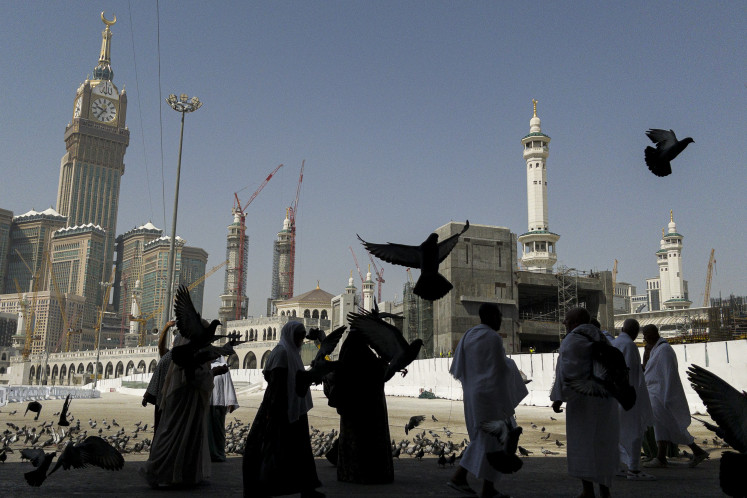The essence of jazz
Perhaps no other event in Indonesia draws a crowd as diverse or unique as the Jakarta International Java Jazz Festival

Perhaps no other event in Indonesia draws a crowd as diverse or unique as the Jakarta International Java Jazz Festival.
Entire families, children and grandparents in tow, joined tens of thousands of trilby-wearing jazz cats, teenagers in hip getups, international visitors and thousands of musicians for the 5th Java Jazz Festival from Friday to Sunday, an event dedicated to the ever-evolving and widely interpreted movement of jazz.
Perhaps it was the reduction in ticket prices or increased capacity that brought record numbers this year, but more likely it was the sheer number of varied acts that drew together this melting pot of music enthusiasts. While the motto for the event, "A Festival For All", could be interpreted as an invitation to guests of all musical tastes, it was interesting to hear performers say it really encapsulated the inclusive, positive and creative approach to jazz music that international events often lack and for which Java Jazz is becoming globally renowned.
Organizers have long grappled with the difficulty of presenting this festival as a "jazz" event, largely because jazz is constantly changing and it would be difficult, even inappropriate, to try and impose a system of rules on its definition. While forms once considered offshoots of the "true" swing- or blues-based jazz of the 1940s and 50s such as bebop, cool jazz, free jazz, fusion, funk, hard-bop and the Latin movements of samba, bossa nova and salsa are still referred to by their original influences, they are generally classified as "jazz" these days.
So to avoid a cultural war of words and labels, the organizers at Java Jazz decided to treat jazz less as a genre and more as a philosophy, or in their words, bringing together "any form of spontaneity, improvisation and the mixture of other musical elements" under one roof. While jazz purists may have been cynical about acts labeling themselves "jazz-fusion" or "new-wave jazz", the reality was this approach to choosing artists ultimately brought acts to Indonesia that never would have made it here any other way - and there really did end up being something for everyone.
Java Jazz succeeded on two levels: It provided a platform for Indonesian musicians and audiences alike to experience a wide range of musical styles from around the globe, and it gave top musicians from the Americas, Europe and elsewhere in Asia a chance to see Indonesia at its creative peak while engaging with a diverse and enraptured crowd open to new ideas.
The audience's willingness to experience different and sometimes challenging musical styles was truly commendable, the crowds respectfully considering the artists before them and applauding enthusiastically (even if there was a lack of dancing, hooting, or other activities that usually indicate audience participation).
With 18 venues, festival-goers could sample different acts freely. This atmosphere catered to originality, allowing artists to play around with their own material and try things out on the audience, as well as join other performers on stage for a jam. Eugenio Toussaint, the pianist from Mexican band Sacbe, introduced a guest guitarist onto the stage he jokingly claimed to have found "in the lobby of the Sultan Hotel", while American guitarist Jason Mraz sang a duet with Indonesian singer Dira on more than one occasion.
Even if at times the venue appeared to be more of a convention than a festival (the lobby was choked with stands offering information on everything from Garuda to Microsoft to IndoVision) and moving between the crowds at times rivaled Jakarta's infamous peak-hour macet, the vibe was consistently cheerful, dynamic and buzzing with anticipation.
While the headliners no doubt provided the festival with some commercial appeal (kudos to Jason Mraz though, arguably the least jazzy act on the bill, who included a brass section and keys to his performance to provide a bluesy, soulful and brilliant revamp of his most popular tunes), the real magic was to be found in the lesser known or up-and-coming artists. A Japanese nu-jazz samba group Quasimode offered one of the most energetic and technical performances of Saturday night, while another Japanese "Death Jazz" group, known as Soil and Pimp, incorporated jazz, thrash metal, ballads and megaphones into a truly electric and innovative show. A Chilean Latin/bebop group, Cristian Cuturuffo Quinteto, performed a blisteringly fast and experimental set incorporating a wide range of emotions, while Indonesian funk group Idang Rasjidi had a packed house bopping to a solidly laid groove.
A mention must go out to the Harvey Mason Quartet (interestingly, there were only three players on stage) and the Ron King Quartet, both seasoned American groups whose performances were as polished, proficient and unique as any to be found in New York's leading jazz clubs.
Toussaint and his brothers have played together for 32 years and toured the world with their Mexican group Sacbe, but only for the first time reached Asia this year for the Java Jazz Festival. His sentiments go a long way toward explaining what it is that makes Java Jazz such an internationally special event.
"I really like the motto of this jazz festival, which is jazz for all. That means everyone. Now that has included Mexico, and we are in Asia, so for that, we thank you."









